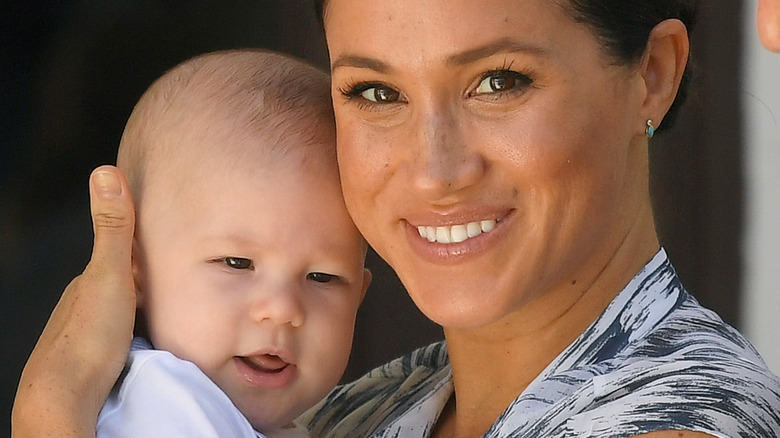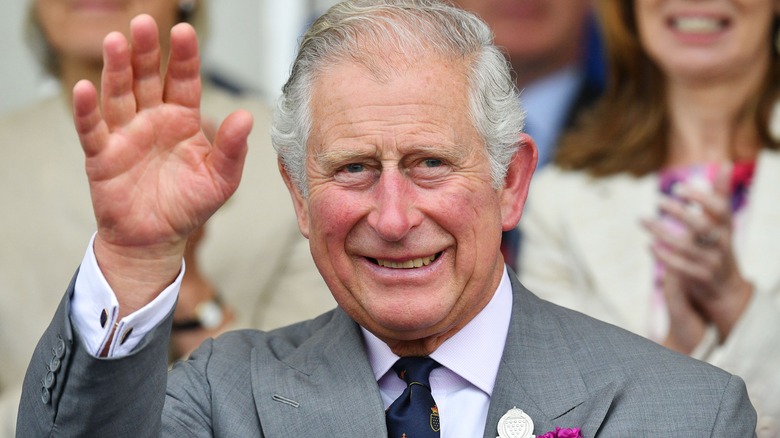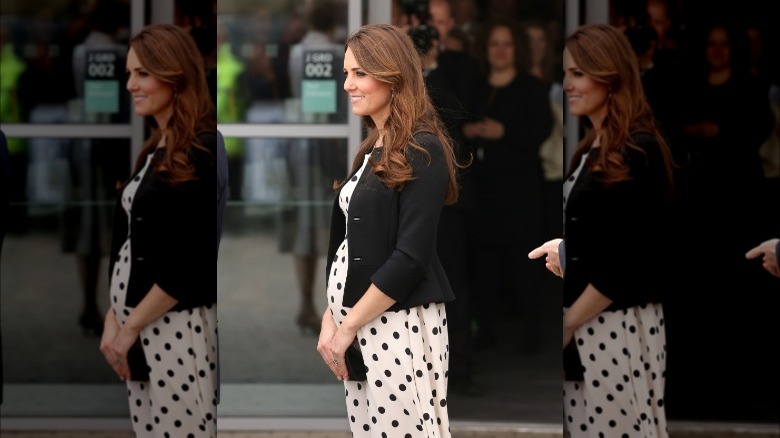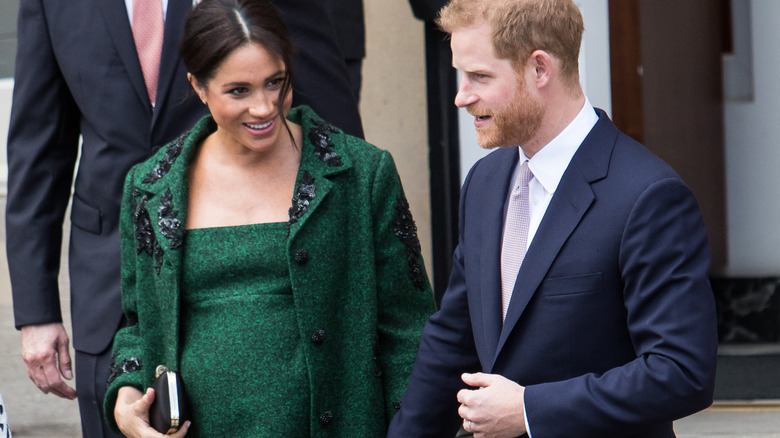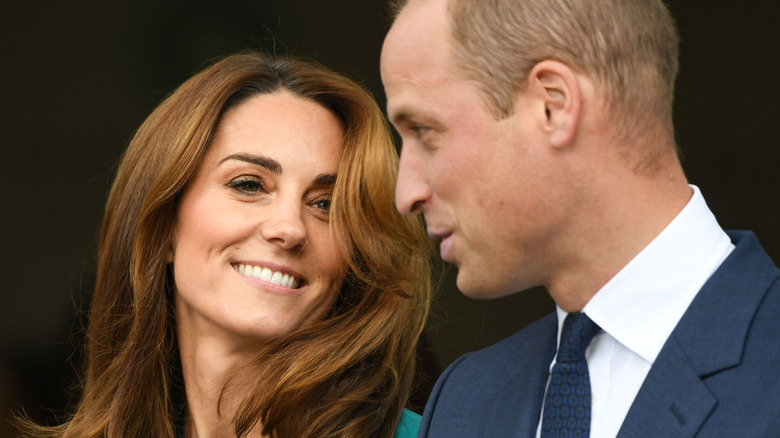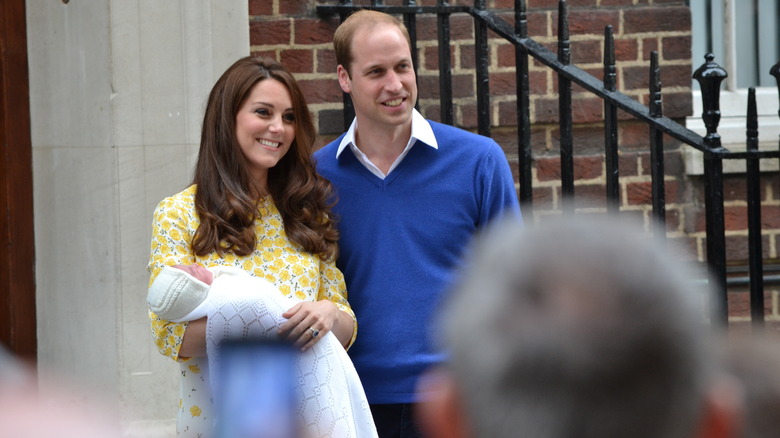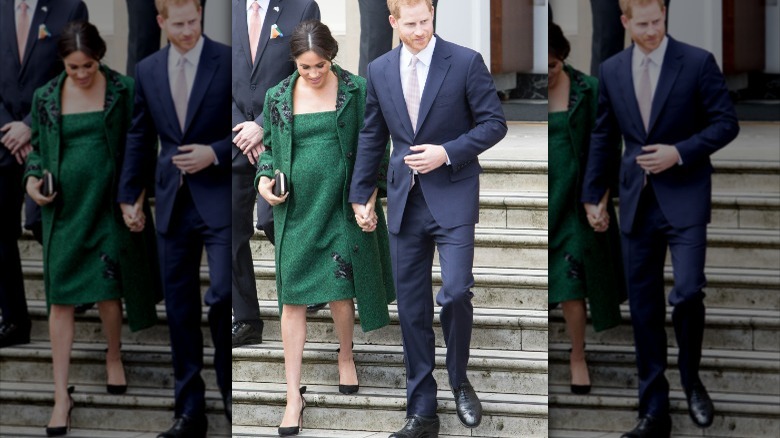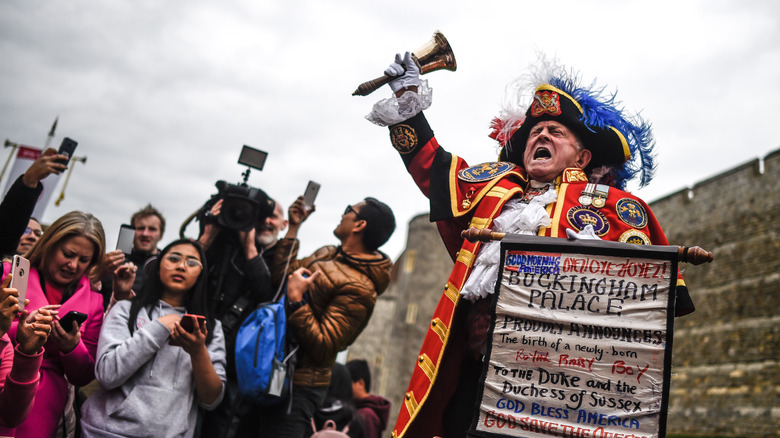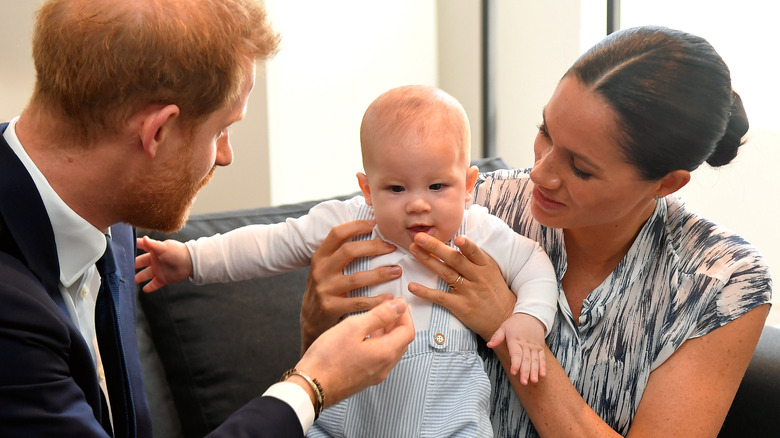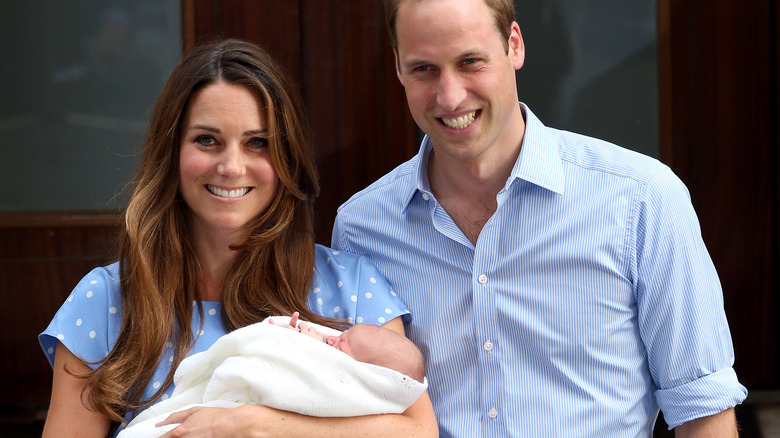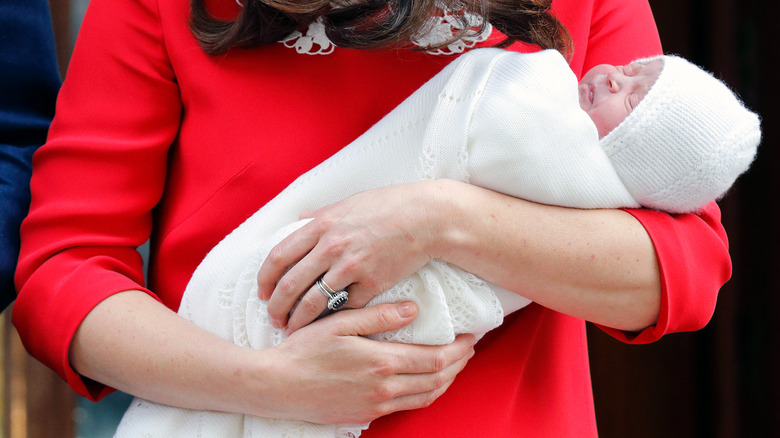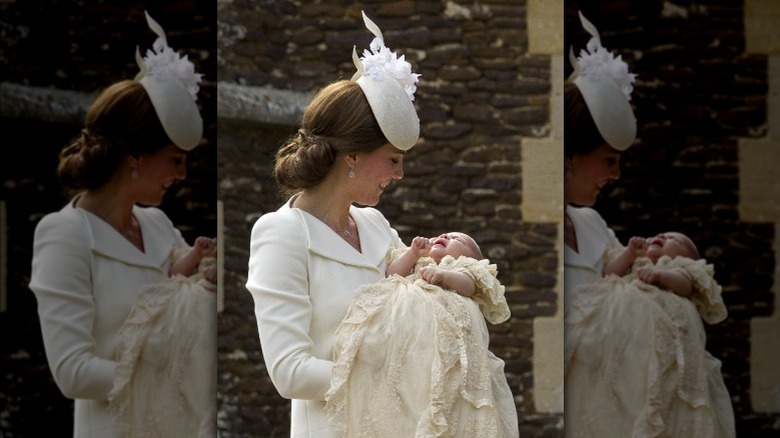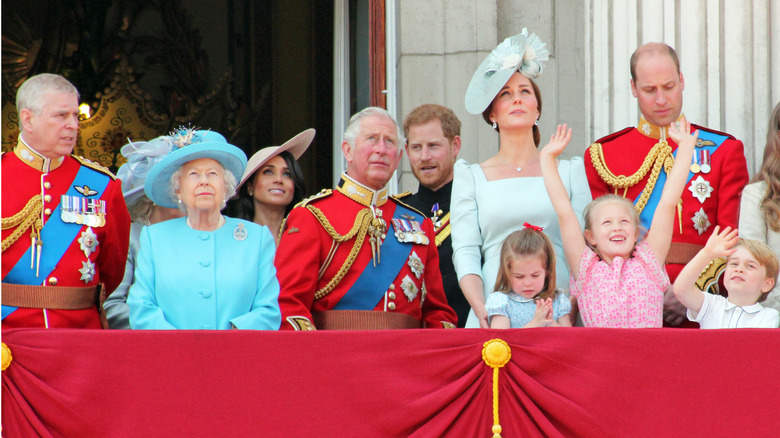Rules Royals Have To Follow When Having A Baby
We might be living in the 21st century, but the birth of a royal baby is still as big a deal as it was a hundred years ago. The press frenzy surrounding royal births has continued for decades, and we can't help but tune into the hype when a new royal is about to arrive — the excitement is simply contagious.
For the royals themselves, the birth is also a big event. Princess Diana felt so pressured by the media that she ended up asking doctors to induce labor when she was pregnant with Prince William (via Town & Country), and Princess Catherine reportedly had a team of around 20 medical professionals seeing to her during her pregnancy (via People). Other royals, like Zara Tindall, have more dramatic birth stories — Zara gave birth to her son on the bathroom floor of her house. The little man was in quite a hurry, and her husband, Mike Tindall, helped deliver the baby, Express reports.
There's no arguing that royals have a lot of added pressure when it comes to having a baby. While the rest of us only worry about bringing a little human into the world, they have several rules and protocols to adhere to in addition to becoming new parents. Read on to discover what some of these rules entail and why they are important to the royal family.
The ruling monarch is the first one to be informed of the birth
When a royal baby is born, it's royal protocol to break the news to the ruling monarch first (via Vanity Fair). When Princess Catherine gave birth to her first child, Prince George Alexander Louis of Cambridge, Prince William called Queen Elizabeth II on an encrypted phone to ensure she would be the first to receive the news without it being intercepted somehow.
According to the Daily Mail, other higher-ups are notified of the birth after the ruling monarch is informed. In the case of William and Princess Catherine, their private secretary, Jamie Lowther-Pinkerton, informed the British Prime Minister of the birth, after which the Archbishop of Canterbury was informed of the good news. Once the Archbishop and Prime Minister are informed, Buckingham Palace officials start to call other officials, including the First Ministers of Northern Ireland, Wales, and Scotland. The news is also distributed to the 54 individuals who head the Commonwealth countries.
That's a lot, but we expect no less of the royal family. Of course, the other royals and the rest of the couple's family are also informed after the ruling monarch receives the news. Now that the queen has passed away, King Charles III will most likely continue the tradition of being the first to know when he has gained another grandchild.
The exact due date is typically not announced to the public
The royals like to keep the exact date their baby is due a secret from the public, Marie Claire reports. That is, of course, their right, but we won't deny that the wait and guessing can be excruciating.
When Princess Catherine was pregnant with her first child, there were tons of speculation about when the baby might be due, with reporters camping out in front of St. Mary's Hospital as the speculated due date crept closer, Vanity Fair reports. There were a few false reports about Catherine going into labor on a few occasions, which, understandably, caused several social media frenzies. The media was on high alert, but baby George wasn't in much of a hurry. Eventually, the media dubbed the waiting period "the Great Kate Wait," a nod to every reporter and royal fan out there who was eager to be the first to know about the new baby. The world only knew the exact due date once the baby's birth was announced.
It was the same way with Meghan Markle. When it was announced that she was pregnant with Archie, the palace didn't divulge many details. They simply said that she was due to give birth in the spring of 2019, and that was it.
Baby showers are not a thing in the royal family
The royal family actually doesn't host baby showers for mothers-to-be, and it's not for the reasons you might think.
First of all, while baby showers are practically a given in the United States, they're not that popular in British culture, ABC News reports. The whole purpose of a baby shower, as we all know, is to gift the new mother with whatever she may need once the baby is born. It saves parents tons of cash, and of course, having an excuse to have a get-together with friends and family is always welcome. Royal expert Victoria Arbiter, however, explained that the royal family has more than enough resources to provide mothers-to-be with everything they need to look after their newborns. "[There's the] added pressure that they are clearly very wealthy, and a lavish baby shower would be seen as highly inappropriate," Arbiter explains. "There's nothing they can't go out and buy themselves."
In addition to forgoing baby showers, royals also aren't allowed to accept any baby gifts that are sent to them. If they do receive any, they are required to respectfully return it to the sender, Arbiter says. It is, however, acceptable for the couple to ask people to make charitable donations instead. These rules have been bent, however. Meghan Markle, for example, had a baby shower, but it was held in New York by her friends, and apparently, it was a surprise, Town & Country reports.
The parents typically keep the baby's gender a secret
One of the reasons the birth of a royal baby is such an exciting event is because the public knows the bare minimum beforehand — due dates are not made public, and neither is the baby's gender. This is in line with royal tradition, Harper's Bazaar reports. Not only is the baby's gender kept a secret from the public, but the parents typically don't find out the gender beforehand. If the couple does decide to find out the gender before the baby is born, they don't share it with the public. Princess Catherine and Prince William were seen honoring this tradition with all three of their children. Royal officials told the BBC that the couple decided together that they wanted the baby's gender to be a surprise when Catherine was pregnant with their first child.
When Meghan Markle and Prince Harry were expecting their first child, they also honored this tradition. While she was attending the Endeavour Fund Awards in 2019, Meghan revealed that she and Harry had no idea if they were having a boy or a girl. "Yes, we decided to keep it a secret," she told the media at the time. Royal expert and historian Marlene Koenig told Harper's Bazaar that finding out the gender is more of an American tradition anyway. "I cannot think of any British or European royal announcing the sex of a child before the announcement is made," she added.
Royal babies are delivered by a team of royal doctors
The birth of a royal baby is a big deal, and so are the doctors who deliver them. According to the Independent, it is tradition to have at least one doctor appointed by the royal family present at the birth. These doctors typically serve the royal family for a long time — obstetrician-gynecologist Marcus Setchell, who was Queen Elizabeth II's doctor, even postponed his retirement to deliver Princess Catherine's first child, Vanity Fair reports.
The royal family now has two senior royal doctors: surgeon-gynecologist Alan Farthing and consultant obstetrician Guy Thorpe-Beeston, per The Telegraph. Both were present to deliver Prince George, Princess Charlotte, and Prince Louis. There's also a pediatrician and neonatologist at the mother's disposal as well as midwives. All in all, the birthing team typically consists of 20 or more medical professionals, and they are on high alert as the pregnancy nears its end. "We were on call for three months," anesthesiologist Dr. Johanna Bray told Town & Country in 2018 after the birth of Prince Louis. "You never know when you need to be called—you need to be in town and available," she added. Consultant obstetrician and gynecologist, Professor Tiong Ghee Teoh revealed that the big team is due to the royal family wanting to ensure that there are professionals ready to handle any problem that might arise during the birth. He also added that they were all "sworn to secrecy."
Royals can give birth at home or at the hospital
According to Cosmopolitan, royals used to give birth at home — in fact, Queen Elizabeth II gave birth to all four of her children in the comfort of her own home. Now, however, it's kind of become an unofficial rule that royals give birth at the Lindo Wing at St. Mary's Hospital in London. According to Vogue, the hospital's private birthing suites are fit for royalty — think champagne menus, super fast wifi, and delicious food.
According to People, home births started to go out of fashion with the royal family when Princess Anne decided to give birth at St. Mary's Hospital's Lindo Wing. Princess Diana and Kate Middleton followed suit, effectively turning it into a new tradition. Meghan Markle and Prince Harry, however, reportedly wanted to follow the old royal tradition of having a home birth, but Meghan ended up having her firstborn at Portland Hospital in London instead (via The Washington Post). While this meant that they didn't follow in the footsteps of those before them, they weren't the first to do so — Town & Country reports that Sarah, Duchess of York, gave birth to both Princess Beatrice and Princess Eugenie at Portland Hospital. Princess Eugenie has since also given birth at the same hospital. At this rate, Portland Hospital might become just as popular for royal births as St. Mary's.
The birth is announced by the palace and on social media
Before social media, the palace was the sole announcer of royal births. Even though royals now have social media at their disposal, this tradition is still upheld. According to British Heritage, the palace officially announces the birth of a royal baby by placing a golden easel in its forecourt. The easel contains a framed document announcing the baby's birth, which is traditionally signed by the royal doctors who helped deliver the baby, People reports. In addition to the easel being put on display, the palace also still honors the age-old tradition of having the town crier announce the details of the baby's birth to the crowds gathered outside the hospital (via Style).
These days, royals take to their social media accounts to announce the birth of their babies in addition to the palace's official announcement. Princess Catherine and Prince William were the first members of the royal family to do this, and others have followed suit. In fact, when Princess Eugenie gave birth to her first child in 2021, the palace utilized its official Instagram account to announce the news.
The baby's name isn't immediately made public
The royals love to keep us hanging when it comes to the birth of their children, and even though the public is usually informed about the birth pretty soon, the baby's name is not made public immediately.
Princess Catherine and Prince William waited two days to announce both Prince George and Princess Charlotte's names, Insider reports. One might think that making everyone wait two days is more than enough, but the royal couple took even longer to announce the name of their third child. The Independent reports that Prince Louis' name was announced three days after his birth. Prince Harry and Meghan Markle honored this tradition as well, sharing the name of their firstborn child with the public two days after he was born (via Harper's Bazaar).
The royals have various reasons for waiting a few days to make the name of their new baby public, royal commentator Victoria Arbiter says. "On one hand there's a desire to inform the families before a public declaration is made and any new parent appreciates having a little private time to get to know their new addition before the onslaught of announcements," she told Town & Country. She added that there's also a lot of pressure on the new parents to get the name just right. "I expect they want to be a hundred percent certain of their choice before announcing the name and sealing the baby's place in history," Arbiter says.
A picture has to be taken of the parents and their newborn
According to Vogue, King Charles and Princess Diana started the tradition of posing on the Lindo Wing's stairs at St. Mary's Hospital with their newborn baby. Princess Catherine and Prince William honored this tradition with all three of their children. We can't imagine facing a slew of photographers shortly after giving birth, but the royals make it look easy (we're pretty sure it isn't, however).
When Catherine was pregnant with her third child, Express reported that she'd hoped to have the baby at home. But, as we all know, that didn't happen. According to royal commentator Richard Fitzwilliams, the photo on the hospital steps has become somewhat of an iconic moment that the media and public look forward to, which puts pressure on the royals to show up. "[Catherine] might prefer to give birth in a palace but the photos on the hospital steps of St. Mary's are a way of connecting with the public at large at a happy time," he explained to Express at the time.
While posing on the Lindo Wing's steps has become somewhat of a tradition, it's not set in stone — royals can have the photo taken elsewhere as long as it gets done. Prince Harry and Meghan Markle, for example, had a private photo session two days after Archie's birth at St. George's Hall at Windsor Castle.
The baby needs to be wrapped in a special blanket
If you're a royal baby, you get wrapped in an exquisite blanket for your first photo-op. According to Vogue, Queen Elizabeth II first started the tradition of wrapping a newborn royal baby in a G.H. Hurt & Sons blanket when she had King Charles in 1948. The knitwear company, based in Nottingham, is probably forever thankful to the queen for choosing to swaddle her firstborn in one of their blankets.
Royals have continued to uphold this tradition. When Princess Catherine and Prince William showed off Prince George to the world on the steps of the Lindo Wing at St. Mary's Hospital, he was wrapped in one of the knitwear company's merino wool shawls, the Independent reports. Princess Charlotte, on the other hand, was swaddled in one of their scalloped edge wraps. Prince Louis was snuggled up in the Nottingham Lace Knitted Baby Shawl. When Prince Harry and Meghan Markle posed for their first family photo, Archie was also wrapped in a G.H. Hurt & Son blanket, Vogue reports.
Royals are required to baptize their children
Photo-ops and luxurious blankets aside, another important tradition royals have to uphold is baptizing their children. This is because Queen Elizabeth II was the Defender of the Faith and Supreme Governor of the Church of England, the Daily Mail reports. This responsibility now falls to King Charles III, so the tradition of baptizing royal children will likely continue to be upheld.
The baptism itself also requires parents to follow a few royal protocols, one of which is dressing their bundle of joy in a very specific christening gown. Originally, royal babies were dressed in a gown designed way back in 1841. Queen Victoria dressed her eldest daughter in this gown for her baptism, and it's been worn by royal babies ever since, including King Charles, Prince William, and Prince Harry. Now, this gown is being preserved, and modern royal babies wear a Honiton lace and white satin gown that is a replica of the original. It's been in use since 2008, and Princess Catherine and Prince William's children wore it for their baptisms, as did Prince Harry and Meghan Markle's firstborn son, Archie (via Time).
Aside from ensuring the baby wears the right gown, the royal parents also can't choose just anyone to perform the baptism — the task is that of the Archbishop of Canterbury, Cosmopolitan reports.
The baby traditionally gets three names
When you're a member of the royal family, having just one name simply won't do. The Independent reports that royals are usually required to choose three names for their newborn baby. While that might sound like a lot of names to come up with, some of the names given usually honor other royal family members, so royals don't have to spend tons of time trying to come up with three unique names, at least. Some royals have more than three names — Prince William, for one, has four. This means that many royals actually share the same name.
Royals who are further down the line of succession, however, don't necessarily need to choose a royal name for their baby and can go with more traditional names if they want to, author of "Raising Royalty: 1,000 Years of Royal Parenting" and professor of history at the University of Toronto School of Continuing Studies, Carolyn Harris, told Vogue.
Aside from giving their baby three names, parents also need to inform the ruling monarch of the name before they make it public. Royal commentator Kate Williams says this is more of a formality than anything else since the monarch doesn't need to approve the name. While the ruling monarch might not interfere with the baby's name, they are, however, still the only ones who get to bestow titles on the new royal.
